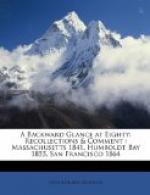One of the most striking coincidences I ever knew occurred in connection with the comparatively mild earthquake of 1866. It visited us on a Sunday at the last moments of the morning sermon. Those in attendance at the Unitarian church were engaged in singing the last hymn, standing with books in hand. The movement was not violent but threatening. It flashed through my mind that the strain on a building with a large unsupported roof must be great. Faces blanched, but all stood quietly waiting the end, and all would have gone well had not the large central pipe of the organ, apparently unattached, only its weight holding it in place, tottered on its base and leaped over the heads of the choir, falling into the aisle in front of the first pews. The effect was electric. The large congregation waited for no benediction or other form of dismissal. The church was emptied in an incredibly short time, and the congregation was very soon in the middle of the street, hymnbooks in hand. The coincidence was that the verse being sung was,
“The seas shall melt,
And skies to smoke decay,
Rocks turn to dust,
And mountains fall away.”
We had evening services at the time, and Dr. Stebbins again gave out the same hymn, and this time we sang it through.
The story of Golden Gate Park and how the city got it is very interesting, but must be much abridged. In 1866 I pieced out a modest income by reporting the proceedings of the Board of Supervisors and the School Board for the Call. It was in the palmy days of the People’s Party. The supervisors, elected from the wards in which they lived, were honest and fairly able. The man of most brains and initiative was Frank McCoppin. The most important question before them was the disposition of the outside lands. In 1853 the city had sued for the four square leagues (seventeen thousand acres) allowed under the Mexican law. It was granted ten thousand acres, which left all land west of Divisadero Street unsettled as to title. Appeal was taken, and finally the city’s claim was confirmed. In 1866 Congress passed an act confirming the decree, and the legislature authorized the conveyance of the lands to occupants.
They were mostly squatters, and the prize was a rich one. Congress had decreed “that all of this land not needed for public purposes, or not previously disposed of, should be conveyed to the persons in possession,” so that all the latitude allowed was as to what “needs for public purposes” covered. There had been agitation for a park; indeed, Frederick Law Olmstead had made an elaborate but discouraging report, ignoring the availability of the drifting sand-hills that formed so large a part of the outside lands, recommending a park including our little Duboce Park and one at Black Point, the two to be connected by a widened and parked Van Ness Avenue, sunken and crossed by ornamental bridges.




